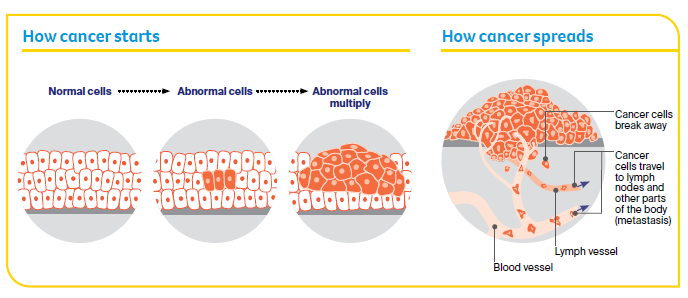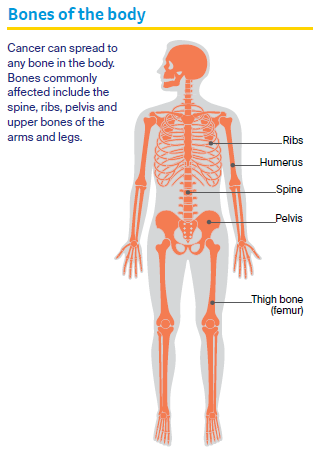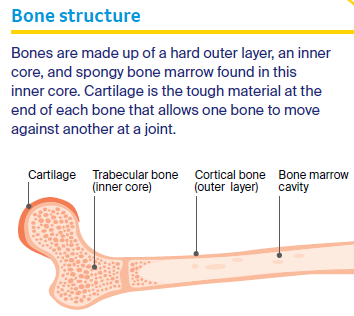Page last updated: October 2024
The information on this webpage was adapted from Understanding Secondary Bone Cancer - Information for people affected by cancer (2024 edition). This webpage was last updated in October 2024.
Expert content reviewers:
This information was developed with the help of a range of health professionals and people affected by secondary bone cancer:
- Prof Angela Hong, Radiation Oncologist, Chris O’Brien Lifehouse, and Clinical Professor, The University of Sydney, NSW
- Anne Booms, Nurse Practitioner Supportive and Palliative Care, Icon Cancer Centre Midlands, WA
- A/Prof Richard Boyle, Orthopaedic Surgeon, Royal Prince Alfred Hospital Sydney, NSW
- Belinda Fowlie, Bone Tumour Nurse Practitioner Candidate, SA Bone and Soft Tissue Tumour Unit, Flinders Medical Centre, SA
- Dr Tahlia Scheinberg, Medical Oncologist, Chris O’Brien Lifehouse, NSW
- Dr Clare Zachulski, Palliative Care Specialist, Westmead Hospital, NSW
This page will help you understand more about secondary bone cancer - cancer that has spread to the bone from another part of the body.
After finding out that you have advanced cancer, you may feel a range of emotions including fear, anxiety, sadness, depression or anger.
Your doctor, nurses, a social worker or counsellor can help you and your family find ways to cope with how you're feeling. Call Cancer Council 13 11 20 for more information and support.
What is secondary bone cancer?
Bone cancer can develop as either a primary or secondary cancer. These two types are different:
- Primary bone cancer means the cancer first started in the bone. It is a rare cancer.
- Secondary bone cancer means the cancer started in another part of the body but has now spread (metastasised) to the bone.
Secondary cancer in the bone, also called bone metastases or bone mets, often keeps the name of the original cancer. For example, breast cancer that has spread to the bone may be called secondary or metastatic breast cancer.
Because the cancer has spread, it is considered advanced or stage 4 cancer. Cancer cells can spread from the original cancer, through the bloodstream or lymph vessels, to any of the bones in the body.

Bones commonly affected by secondary bone cancer include the:
- spine
- ribs
- pelvis
- upper bones of the arms (humerus) and legs (femur).
Which cancers spread to the bone?
Any type of cancer can spread to the bone, but those most likely include:
- prostate cancer
- breast cancer
- lung cancer
- kidney cancer
- thyroid cancer
- myeloma (a type of blood cancer)
- melanoma.
How common is secondary bone cancer?
Secondary bone cancer is much more common than primary bone cancer in Australia and it is more common in adults than children.
The bone is one of the most common sites cancer may spread to, along with the lymph nodes, liver, lungs and brain.
Secondary bone cancer is always caused by cancer cells spreading to the bone from a primary cancer elsewhere in the body. It isn't fully understood why some people develop secondary bone cancer and others don’t.
About the bones
Bones have a number of important functions. These include:
- supporting the body
- protecting internal organs
- attaching to muscles to allow movement
- containing bone marrow, which produces and stores new blood cells
- storing proteins, minerals and nutrients, such as calcium.

Bones are made up of different parts, including a hard, outer layer (known as cortical or compact bone) and a spongy inner core (known as trabecular or cancellous bone).
Bone marrow – a substance containing fat and blood stem cells that can become red blood cells, white blood cells, or platelets – is found in this spongy core.
Cartilage is the tough material at the end of each bone that allows one bone to move against another at a joint.
Normal bone is constantly going through a process called remodelling, or turnover, in which old bone is broken down and replaced with new bone.

Types of secondary bone cancer
There are two main types of secondary bone cancer:
- Osteolytic - where bone is broken down by the cancer cells without being replaced by new bone. Holes, also called lytic lesions, might form in the bone, which increases the risk of a break or fracture.
- Osteoblastic - where new bone cells form abnormally in some areas. These areas are called osteoblastic (or sclerotic) lesions and even though they are very hard (dense), they make the bone weak and deformed.
Most people with secondary bone cancer develop either osteolytic or osteoblastic changes, but some have both.
“We learn a lot more about our body and about life than a lot of people ever learn.” Margaret
What are the symptoms?
These are some signs and symptoms of secondary bone cancer. If you notice any of these symptoms, see your doctor.
- Bone pain – This is often the first and most common symptom. The pain may be a dull, persistent ache. It can get worse with movement and is often worse at night.
- Fractures – Cancer cells can weaken the bones and cause them to break more easily, often with little or no force (this is known as a pathological fracture).
- High calcium levels in the blood (hypercalcaemia) – As the bone breaks down, calcium is released into the bloodstream. When calcium builds up in the blood, it may cause severe tiredness (fatigue), a feeling of sickness (nausea), vomiting, thirst, constipation or confusion.
- Pressure on the nerves in the spine (spinal cord compression) – Abnormal bone growth or fractures can press on the nerves in the spine. This may cause back pain, muscle and limb weakness, tingling or numbness of the limbs, difficulty walking, or loss of bowel or bladder control.
- Low levels of blood cells – Secondary bone cancer can affect the bone marrow, particularly if there is a large amount of spread to the bones. The bone marrow makes blood cells, so the cancer can lead to low levels of blood cells. Symptoms depend on the type of blood cells affected. You may feel tired and breathless, have an increased risk of infections, or bruise and bleed more easily.
Finding support
When you call the Cancer Council support line on 13 11 20, you’ll talk to a cancer nurse and get the support you need.
It’s free, confidential, and available for anyone affected by cancer who has a question – those diagnosed as well as their family, friends, and carers.
Contact cancer support
Diagnosis
Secondary bone cancer may be found at the same time as the primary cancer. It can also be found months or years after the primary cancer has been treated.
Sometimes, secondary bone cancer is diagnosed before the primary cancer is found, and in some cases, the primary cancer cannot be found. When tests can’t find where the cancer started, this is known as cancer of unknown primary (CUP).
If your doctor is concerned the cancer has spread to the bones, you may have some tests, including a:
- blood test – usually a full blood count, a check of your calcium levels and possibly a specific blood test called an alkaline phosphatase (ALP) test
- bone x-ray – a scan to show bone damage, fractures or creation of new bone
- bone scan – a small amount of radioactive dye is injected into a vein; it collects in the bone and any abnormal changes are found by a special camera and computer
- CT or MRI scan – CT (computerised tomography) and MRI (magnetic resonance imaging) scans create detailed cross-sectional pictures to highlight any bone abnormality; they take between 30 and 60 minutes
- PET–CT scan – this is a PET (positron emission tomography) scan combined with a CT scan, which provides more detailed information than a CT on its own; you are injected with a small amount of radioactive glucose solution, which will highlight any cancerous areas on the scan
- bone biopsy – removal of some cells and tissue from the affected bone for examination under a microscope. The biopsy may be done in one of two ways. In a core needle biopsy, local anaesthetic numbs the area, then a thin needle is inserted to remove a sample of bone. In a surgical biopsy, a surgeon removes a small section of bone under general anaesthetic. The sample is sent to a pathologist who checks it for cancer cells.
Prognosis
Prognosis means the expected outcome of a disease. Factors affecting prognosis include:
- whether the cancer has spread to other parts of your body
- the type of primary cancer
- how quickly it is growing, and
- its response to treatment.
It is not possible for anyone to predict the exact course of the disease, but your doctor can provide you with general information on the expected outcomes of people in a similar situation to you and discuss treatment options.
The expected outcome also depends on the site that the cancer started from (i.e. the prognosis of the primary cancer).
Secondary bone cancer can’t always be cured, but treatment can reduce symptoms and improve quality of life. In some cases, treatment can keep secondary bone cancer under control for many years.
Understanding Secondary Bone Cancer
Download our Understanding Secondary Bone Cancer fact sheet to learn more.
Download now
